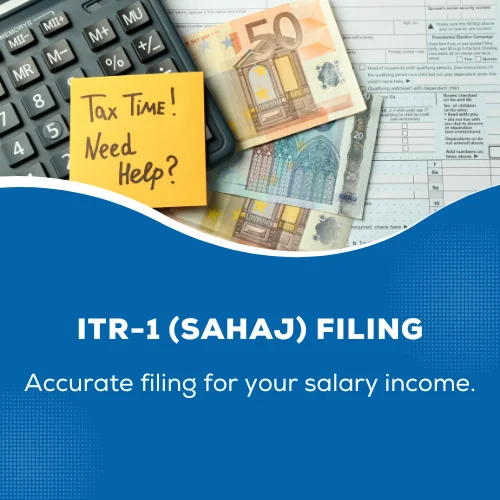ITR-1 (Sahaj) Filing
File Your ITR-1 in Just a Few Clicks!
If you are a salaried person with no complex income, ITR-1 is the right choice for you.

Don’t Wait Until the Last Minute – File Now!
- Get Instant Quote
What’s Included ✅
- Consultation on Eligibility for ITR-1
- Preparation & Online Filing of ITR-1 Form
- Computation of Taxable Income & Refunds
- Claiming Deductions (like 80C, 80D, etc.)
- Filing Acknowledgment (ITR-V) & E-Verification Support
- Expert Support for Salary & Simple Income Cases

Exclusive Free Benefits 🎁
- Simple tax saving tips – keep more money with you.
- Refund tracking support – we’ll monitor it for you.
- Easy document checklist (PDF) – know what to arrange.
- One free call on tax planning – prepare better for next year.
- Consultation with CA/CS/Advocate Free for Lifetime
10,000+ Companies & Individuals Put Their Trust In Us
























✅ Clear Guidance: They explained every step in simple, easy-to-understand terms, so I always knew what was happening.
✅ Fast & Efficient: My filing was completed quickly without any unnecessary delays.
✅ Accuracy & Trust: I felt confident knowing my details were handled with care and precision.
✅ Great Support: Any small questions I had were answered patiently and thoroughly.
ITR 1 (SAHAJ) Form for Income Tax Return Filing
It is crucial for the taxpayers of India to file income tax returns. But when it comes to Income tax return filing, it will be crucial or can be confusing to choose the right form. In order to choose the right one, taxpayers have to determine their residential status in India (among resident, non-resident, or resident but not ordinarily resident) one of the simplest forms that have been provided by Income Tax Department for filing individual Income Tax return is ITR 1 which is also known as “SAHAJ”.
You should choose the correct ITR form wisely in order to comply with tax regulations and safeguard your financial interests. Understand everything about ITR 1 properly with the help of top online income tax return filing portals like Click To Professionals.

What is ITR-1?
Who is Eligible for filing ITR-1?
We will provide you with a general understanding of who is typically eligible to file ITR 1 form in India. The ITR-1 form in India is primarily meant for the salaried individuals. Here are the key eligibility criteria for filing ITR-1. It can be filed by the Resident Individuals whose total income during financial year includes the following:
- Income that has been received as salary or pension.
- Your total income should not be more than Rs. 50 lakhs.
- Income from a single house property (except such cases where losses are brought forward from previous years)
- Interest Income from saving accounts, fixed deposits, recurring deposits, etc.
- Income from family pension
- Income from Income Tax Refunds
- You need to report the agricultural income within a specified limit in the form ITR-1.
- The agricultural income up to Rs. 5,000/-

Who is Not Eligible to File ITR-1?
You are not eligible to file ITR-1, if, in case you:
- Are a RNOR i.e. Resident Not Ordinarily Resident and NRI i.e. Non- Resident Indian
- Have total income exceeding Rs. 50 lakhs
- Have agricultural income more than Rs. 5000/-
- Have income from lottery, horse race, legal gambling etc
- Have taxable long term & short term capital gains
- Have invested in unlisted equity shares
- Have income from business or profession
- Have foreign assets or income
- Are the Director in a company
- Have tax deduction under section 194N of Income Tax Act
- Have deferred Income Tax on ESOP that has been received by the employer being an eligible start – up
- Own & have income from more than one house property
- Are not covered under the eligibility conditions for ITR 1
In order to understand the eligibility criteria properly, you should seek the professional guidance of Income Tax Return Filing consultants.
Protections Under ITR-1 Form
- If your primary source of income is your salary, ITR 1 is a straightforward choice for you. It offers protection by allowing you to report your salary income with ease
- Individuals who have gained income from the sale of assets like property or stocks may find it challenging to use ITR 1 as it does not provide the necessary protection for these types of income
- If you have foreign assets, ITR 1 does not provide the protection you need. You might not be able to adequately report foreign income and assets
- In cases where an audit is likely, ITR 1 might not provide adequate protection. It's designed for simpler financial structures
- In cases where an audit is likely, ITR 1 might not provide adequate protection. It's designed for simpler financial structures
- For individuals with non-resident income, ITR 1 may not offer sufficient protection or flexibility
- Income from lotteries, horse racing, and other specified sources can't be adequately protected in ITR 1
Income Tax Return Due Date
- The Income Tax Return last date for filing ITR 1 is typically the same as for other forms, providing protection from penalties for late filing
- Usually the last date of filing ITR 1 will be 31st July until there are any changes made by the government
Structure of Form ITR-1
The form ITR-1 which has been used to file Income Tax Return divides into different sections. In order to navigate the complexities of tax laws, you should have to understand the structure of form ITR-1 accurately. Here is the detailed structure of the form:
- Part A: General Information
- Part B: Gross Total Income
- Part C: Deductions and Total Taxable Income
- In this section you have to mention about the numerous deductions applicable to you including deductions under section 80D, 80C, 80G, etc.
- You also have to mention the total taxable income after deductions.

- Part D: Tax Computation and Tax Status
- Part E: Verification
- Part F: Schedule IT and TDS
Income Tax Return Process
The process of Income Tax Return includes a number of tricky steps. You should have to understand its process properly for which you can seek the professional guidance of expert ITR filing consultants. The major steps are as given below:
- After login, if you are a first time user you have to register yourself.
- If you are the repeat user you have to log in to the website.
- You have to enter your PAN as your user id and then click ‘Continue’.
- You have to check the security message given in the tick box.
- Then, you have to enter your password & click on the ‘Continue’ button.
After that, you have to select the status of filing ITR as Individual and click on ‘Continue’
After that, you have to select the ITR form and you have to choose the ITR 1 then you have to fill the following details:
- Personal information: Your basic details including your full name, PAN, Aadhaar Number, contact details, bank account details.
- Gross total income: You have to enter & verify your total income from all the sources along with the details of exempt income.
- Total deductions: The information about the deductions that you need to be claimed under the different sections.
- Tax paid: Reflects the tax paid by you from all the sources but not been limited to TDS, TCS, Advance Tax & Self – assessment
- Total tax liability: This section reflects the total tax liability as per the information provided by you previously. If the amount is negative then it can be claimed as the refund and if the amount is positive then you have to pay the following amount as tax.
You have to choose the reason for filing the ITR. You have to select the correct option that has been applicable to your situation:
- Taxable income is more than the basic exemption limit
- Meets specific criteria & compulsory requirement of filing the ITR
- Others
Find a local agent for your legal & registration service
+91 8448094507
Phone No.
info@clicktoprofessionals.com
Get Support
Essential Documents Required for Filing ITR-1
- PAN Card of the Taxpayer
- Aadhaar Card
- Form 16 that includes details of salary income and TDS
- Form 26AS for verification of TDS
- Receipts of exemptions and deductions
- Bank Statements/ Passbooks
- Proof of Investments
- Rental Income Details

Key Points to Remember While Filing ITR-1
Ensure Accuracy
You should have to double-check all the details before submission in order to avoid errors and penalties.
Declare All Income
You have to make sure about declaration of all income including all the sources of income even if it gets exempted from tax.
Claim Deductions Wisely
You have to maximize tax-saving instruments as per section 80C as well as other applicable sections.
File Before Due Date
You should take care about the due dates if ITR Filing. Filing after the due date may attract penalties and interest on unpaid taxes.
Save Acknowledgement
It will be better for you to keep a copy of its acknowledgment for the future reference.
Ensure Accuracy
Declare All Income
Claim Deductions Wisely
File Before Due Date
Save Acknowledgement
Common Mistakes to Avoid While Filing ITR-1
Although the process of filing ITR-1 is very simple, still you have to take care of some mistakes that you should avoid while filing this form. Such common mistakes are as given below:
Filing the Wrong Form
You have to make sure that you should meet the eligibility criteria for ITR-1 before proceeding.
Mismatch in Income Details
It will be better to cross-verify the details in Form 16 and Form 26AS and bank statements with the information entered in ITR.
Incorrect Personal Details
You have to declare all your personal details including PAN, Aadhaar, and Bank account details.
Skipping Deductions and Tax Credits
You have to declare all eligible deductions to minimize the tax liability and must verify form 26AS in order to make sure about all TDS Credits are claimed.
Missing the Deadline
Just make sure that you don’t miss the deadline as late filing attracts penalties as per section 234F.
Penalties for Non-Filing of ITR-1
If you fail to file your ITR on time or provide incorrect information can lead to the hefty penalties which are as given below:

Late Filing Penalty u/s 234F
- If you file the ITR after the deadline but before 31st December, a penalty of Rs. 5,000/- may be levied on the taxpayer.
- If you file your ITR after 31st December, the penalty will be of Rs. 10,000/-
- For taxpayers having an income of below Rs. 5 lakhs, the maximum penalty will be Rs. 1,000/-
Interest on Outstanding Tax
- An interest of 1% per month may be charged on unpaid tax liabilities as per the section 234A, 234B, & 234C for delay in payments.
Prosecution
- In severe cases, if you fail to file Income Tax returns may lead to prosecution under the Income Tax Act.
Final Words
It is an essential responsibility for individual taxpayers in India to file income tax returns. Filing ITR-1 is a simple and essential process for salaried individuals and pensioners in India. Income Tax Return Filing not only will make sure about the compliance with the law but also provides numerous benefits including tax refunds and proof of income. You can file their income tax returns precisely and on time by sticking to the eligibility criteria and following the above mentioned steps. Income Tax Return is a big step towards contributing to national development along with protecting your financial health. Just remember timely compliance not just avoids penalties but also helps in maintaining a clear financial record.
What are you waiting for? Contact the experts of Click To Professional now and take a successful step towards a better financial future.











